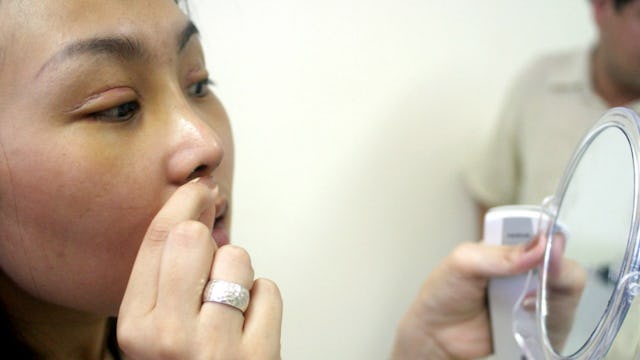Body Dysmorphia Is A Serious Issue And Can Be Triggered By Our Selfie Culture

You’d be hard pressed to find someone who doesn’t find a flaw with their appearance. It may be something like the cellulite on your butt, or the crow’s feet around your eyes, or your belly pooch. Social media can exacerbate our perceived flaws, especially when we see seemingly perfect pictures of our friends and celebrities all over our social media feeds.
But there’s a difference between just hating the way your nose looks if you take a selfie and being so fixated with it that you spend all of your time thinking about how ugly your nose is. Obsessively fixating on a physical “flaw” is actually considered body dysmorphic disorder (BDD), and it is a very serious mental health disorder. It can be exacerbated by today’s selfie and filter culture, but chances are if you have it, you’ve probably had it before our lives became consumed with social media.
So what exactly makes BDD different than just unhappiness with your appearance? Quite simply, it comes down to the level of of preoccupation with the flaw. For example, I don’t like how broad my forehead is. Usually, I get around my self-consciousness with a side-swept bang or by not taking a photo straight on.
But if I had body dysmorphia, I would go to greater lengths to cover my forehead, such as wearing a hat constantly or getting cosmetic surgery. Many people with BDD don’t leave the house or only go out at night to avoid having to face people because their perception of their flaw is so deep that they can’t interact with the public.
BDD is classified as a mental illness, closely aligned with obsessive-compulsive disorder, and according to the International OCD Foundation, BDD is widespread, but also underdiagnosed. According to multiple sources, there are approximately 200,000 new cases every year. Of those who suffer, 40% are male and 60% are female. It can start in people as early as age 2 and continue well into adulthood. Most often, it starts in the early teens.
On a recent episode of Keeping Up With the Kardashians, Kim Kardashian claimed to have developed BDD after an unflattering series of photos of her were published. Though Kim K. didn’t say she’d been formally diagnosed with BBD — an important step — her comment (however flippant it might have been) is a chance to discuss BDD and correct certain misconceptions about the condition.
Societal pressures to fit into a certain standard of beauty can certainly trigger BDD, but BDD is different than general insecurities. While people with BDD may be obsessed with changing their appearance either superficially (changing clothes or accessories constantly) or with surgery, chances are they do not spend a lot of time posting selfies of themselves on Instagram and Snapchat. They typically wouldn’t publish a coffee table book full of selfies, for instance. They are far too concerned with the negative opinions that society has of their perceived flaws. According to Katharine Phillips, MD, “Most people with BDD are mostly convinced or completely convinced that they look ugly or abnormal, even though other people don’t see them this way.”
Often, those who suffer from BDD are severely withdrawn from society. Selfie culture can trigger the anxiety of having BDD, but those who suffer from it are not going to be putting themselves out there for other people to actually scrutinize them. Much of the scrutiny of their looks comes from within, and if they are seeking validation, they are looking to validate what they believe their flaws are, which is why some people become obsessed with surgery and are never satisfied with the results, leading to more surgeries. People with BDD think that they are repugnant and often deformed.
BDD can also lead to other disorders, such as social anxiety disorder, depression, and eating disorders, per the Anxiety and Depression Association of America. The exact cause of BDD is still unknown, and studies need to be conducted to try to gain more insight into who is most affected by BDD. It is still frequently undiagnosed or even misdiagnosed, especially because often those suffering don’t want to admit that they are suffering.
The Mayo Clinic claims that it could be a brain abnormality or biological (studies have shown that BDD is more common with those who have a blood relative with the disorder or obsessive-compulsive disorder). Life experiences and environment can also play a factor, such as childhood abuse or negative social evaluations of one’s looks.
The good thing is that BDD is treatable. Like most mental illnesses, there is no steadfast cure, but there are treatment options. The general consensus is that the best way to treat BDD is first with a proper diagnosis. From there, your mental health professional can come up with the best course of treatment, whether it’s regular therapy sessions, writing in a journal, or even medication. The most important step to managing BDD is getting diagnosed properly.
It can be hard to admit that you suffer from the disorder, but if you truly believe you have it, you should seek help to get it under control. There are therapists who specialize in BDD, and they can properly diagnose the disorder and recommend the best course of treatment. Body dysmorphia is a mental illness. It’s nothing to be ashamed of, and you are not alone.
This article was originally published on